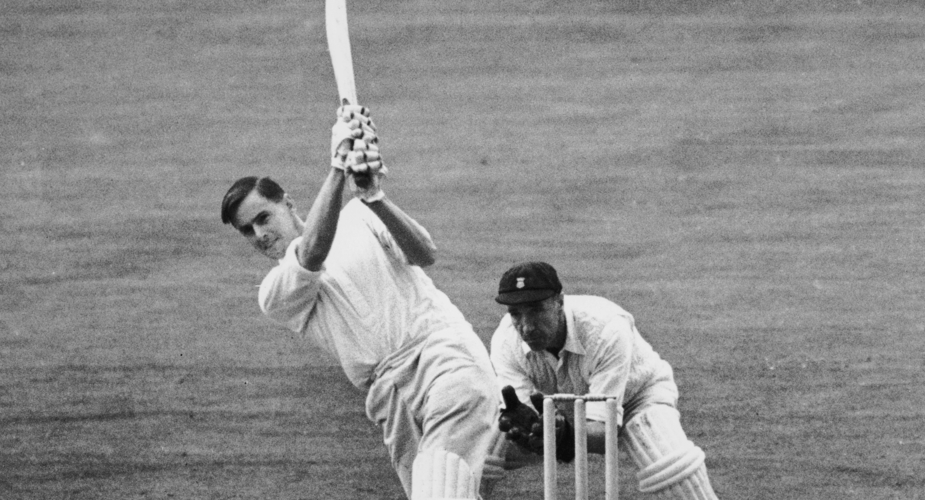An exemplar of England’s acclaimed amateur batting heritage, Peter May earned his reputation as one of the country’s most accomplished post-war batsmen through dutiful adherence to technical mastery.
Born in 1929, his unruffled presence accrued 4637 Test runs against formidable attacks from Australia and the West Indies between 1951 and 1961.
Atoning for early struggles against masterful spin, May blossomed under Len Hutton’s guidance, blending composure with attacking instincts during his peak years as captain between 1955 and 1959. Off the field, he commanded admiration for upholding cricket’s moral code in an age tainted by bribery scandals.
Article Highlights
Hide- Peter May had a strong upbringing in cricket, which played a significant role in his life.
- He rose to prominence in the cricketing world through his technical prowess and strategic acumen.
- May had a successful international career, with notable performances and a captaincy that led England to numerous victories.
- His legacy includes his influence on the strategic and technical evolution of cricket, setting a benchmark for future generations, and his cerebral approach to leadership.
Had his career escaped the injuries and selectorial turmoil prevalent in English cricket, May’s legacy might have surpassed modern greats.
Nevertheless, the MCC President’s etched his name among the game’s most dignified practitioners – a stationary fulcrum around whom England’s fragile batting pivoted for over a decade.
Early Life and Background
Peter May was born on December 31, 1929, in Reading, Berkshire, where he was introduced to cricket at a young age, setting the stage for his future career in the sport.
His early exposure to cricket in the post-Edwardian era, a time when the sport was undergoing significant changes in England, provided May with the foundational skills and understanding of the game that would later define his professional pursuits.
Tom Graveney
Gloucestershire and England batsman Tom Graveney embodied the technical excellence and dignified ... Read More
An examination of May’s formative years reveals a steady progression marked by a blend of innate talent and environmental influence.
Growing up in a society that cherished cricket as a symbol of national pride and individual discipline undoubtedly shaped May’s approach to the game.
His education at Charterhouse School, known for its robust cricketing tradition, further honed his capabilities and nurtured his potential.
Here, May not only developed his technical prowess but also imbibed the ethos of sportsmanship and leadership that would become hallmarks of his playing style.
In this period of personal development, May’s early interactions with cricket were not merely recreational but a prelude to his ascension in the sport’s hierarchy.
The formative experiences from his youth in Berkshire were instrumental in carving his path to becoming a luminary in cricket history.
Rise to Prominence
Catalyzed by his formative experiences and natural aptitude, May’s ascent in the cricketing world was both rapid and remarkable, as he transitioned from a promising schoolboy cricketer to a national sporting icon.
His technical prowess and strategic acumen quickly distinguished him within competitive circles, marking him as a player to watch. With each innings, May’s reputation solidified, his performances resonating with the hopes and aspirations of cricket enthusiasts.
- Pivotal Moments
- Debut Century: His debut century on the international stage was not merely a personal triumph but a beacon of national pride, inspiring a generation to pursue excellence.
- Captaincy Elevation: When handed the captaincy, May’s leadership galvanized a team of diverse talents, fostering a spirit of unity and determination that touched the hearts of fans nationwide.
In dissecting May’s trajectory, it is evident that his rise was underpinned by a combination of innate talent and a relentless pursuit of mastery.
His methodical approach to batting, characterized by a blend of grace and assertiveness, captured the imagination of those yearning for a figure of liberation on the field.
Through his exploits, May carved a legacy that transcended the boundaries of the sport, embodying the essence of freedom in every stroke.
International Career Highlights
Throughout his international career, May’s extraordinary batting skill and tactical insight led to numerous memorable performances, cementing his status as one of cricket’s most esteemed batsmen.
His tenure with the English national team was marked by several standout moments that not only showcased his prowess at the crease but also underlined his importance to the side.
Analyzing May’s career, one cannot overlook his debut series against South Africa in 1951, where he made an immediate impact with a half-century.
However, it was the Ashes series of 1953 that truly elevated his status. His century at Headingley in a pivotal third Test was instrumental in England reclaiming the Ashes after a 19-year drought.
May’s ability to accumulate runs was exemplified in his career-best 285 not out against the West Indies in 1957, a display of concentration and technique.
As captain, his leadership qualities shone through, leading England to 20 victories in 41 Tests between 1955 and 1961. May’s analytical approach to the game, combined with his classical batting style, contributed significantly to the evolution of English cricket strategy during his era.
His international career, encompassing 66 Tests and over 4,500 runs, remains a testament to his enduring legacy in the sport.
Notable Batting Performances
Building on his international career highlights, May’s most notable batting performances further illustrate the depth of his technical proficiency and his ability to influence the outcome of matches with his individual prowess.
As a cricketer par excellence, Peter May’s innings often swung the pendulum in favor of his team, underlining his status as a linchpin in the batting lineup.
Key Innings:
- 285 Not Out vs. West Indies, Edgbaston, 1957
- Cemented his reputation as a premier batsman
- Demonstrated exceptional concentration and stamina
- 112 vs. Australia, Headingley, 1956
- Showcased his technical mastery under pressure
- Vital in setting up England’s victory in a pivotal Ashes Test
May’s performances were not merely statistical triumphs but were instrumental in shaping the very fabric of the matches he graced.
His 285 not out remains one of the highest individual scores for England and is a testament to his enduring legacy in the annals of cricket.
The Headingley century, scored against the formidable Australian attack, exhibited May’s unflappable temperament and strategic acumen, both critical in steering his team to success.
These instances reflect an analytical dissection of his technique and a celebration of his unwavering spirit of freedom on the cricket field.
Legacy and Impact on Cricket
Peter May’s indelible impact on cricket extends beyond his remarkable statistics to the lasting influence he had on the sport’s strategic and technical evolution.
His era was characterized by a strategic shift towards a more dynamic and aggressive style of batting, testing the traditional limits of the game. May, with his technical proficiency and tactical acumen, became a paragon of this transformation.
Analyzing May’s legacy requires acknowledging his role in refining batting techniques that balanced aggression with an unwavering focus on the fundamentals.
His ability to dominate bowlers, without resorting to recklessness, set a benchmark for future generations. The equilibrium he achieved between attack and defense in his batting philosophy has become a template for modern cricketers who seek to innovate without compromising on technique.
Moreover, May’s impact transcended the boundary ropes. His captaincy was marked by a cerebral approach to leadership, influencing his peers and successors to think deeply about the nuances of game management.
The strategic insights he offered during his tenure as a cricket administrator further underscored his commitment to advancing the sport.
Summary
Peter May’s career stands as a testament to his exceptional talent and influence on cricket. His skillful batting and leadership qualities not only garnered individual accolades but also significantly contributed to the evolution of the sport.
May’s legacy is characterized by his technical proficiency and the high standards he set for future generations. His performances remain a benchmark for aspiring cricketers, underscoring the enduring impact of his contributions to the game’s history.

















